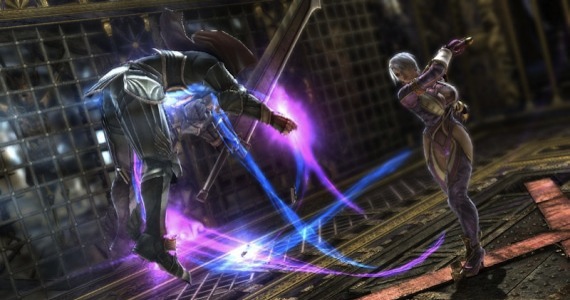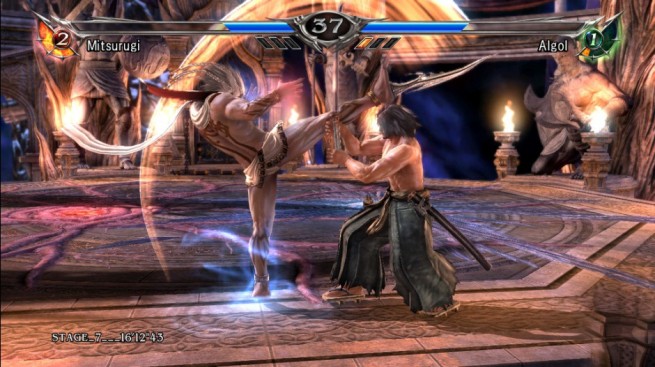WHAT YOU WON’T LIKE:
Lack of tutorials
Soulcalibur V is accessible to newcomers and rewarding for veterans, but becoming the latter can be frustrating. Doing well in the game requires a good understanding of your moves and your opponent’s, and with the large attack pools it’s easy to fall into button-mashing habits or lose to them. It’s not like Street Fighter, where you immediately understand the value of special moves like fireballs and Shoryuken uppercuts.
To its credit, training mode does provide 10 helpful tips for each combatant, and the character-select screen displays charts detailing the fighters’ strengths and ease of use. Still, the game doesn’t offer any other basic training that would help newcomers learn how to not get sliced apart. Soulcalibur III had a robust tutorial when it came out on the PlayStation 2, and I don’t understand why Namco doesn’t bring it back.
Trimmed roster and movesets
SC5 drops a good amount of regulars like Rock and Seong Mi-Na. I don’t mind because for a reboot a new cast can feel refreshing. I can say that, however, because all of my favorites got in, and it can be tough for people to lose a character that they became attached to. Talim, Zasamael, and Yun-Seoung players in particular won’t find anyone who shares a similar weapon.
The developers also cut down on the number of moves each warrior has, which is another philosophical argument. Removing extraneous attacks isn’t a bad thing and helps tone down the learning curve, but some players will miss the extra options. In one extreme case, Ivy lost all of her extra stances, making her feel alien to longtime users.
Mediocre single player
Soulcalibur V’s has similar solo offerings comparable to the rest of the genre. Unfortunately, the game has fewer modes than previous installments, and the execution of what is there is lackluster. The main attraction is story mode, which stars Patroklos and Pyrrha. Both are great choices to learn, and Namco could have used this opportunity to teach beginners how to play. Instead, the player just fights through a series of battles.
The story unfolds through a series of pictures and a few cutscenes. I don’t mind the cheap presentation because no amount of production values can save the actual narrative. The pacing is bad and certain scenes don’t make sense unless you read background information online. Most of the cast only appear once or not at all. In some ways, the game would be better off focusing on character-specific arcade-mode endings, which are strangely absent this time around.
Arcade mode pits you against seven AI adversaries who are pushovers until you reach the final boss. Then it becomes a battle against a demon that will maul you for every single mistake. Legendary Souls pits you against seven of these monsters. To it’s credit, the super-hard difficulty does force you to reach further into your moveset and learn better combos, but few will share those sentiments.
Finally, you have Quick Battle, which mimics online play except you’re going against computer characters that you can earn titles from. Similar to the Virtua Fighter series, the AI here is tuned to mimic different skill levels and habits. Some of them even use tactics you’ll notice online like one Astaroth who mainly relies on his Bull Rush tackle to win. Completing these modes unlocks characters and more creation items, and you can gradually earn this content by playing online or multiplayer as well.
Critics praised this series for its unique campaigns like Weapon Master that feature a variety of challenges and weapons with different properties, but SC5’s offerings feel limited and rushed. As a multiplayer fan, I’m glad Namco focused on fine-tuning the game engine because that is critical to its longevity. Even if I spend most of my time in Training Mode, however, the series does have fans who enjoy all the little features and will feel marginalized.
Conclusion
Today, fighting games have to focus on the combat engine and online play because getting them right is crucial for a title focused on multiplayer. Soulcalibur V will be a main game at Evolution 2012, the largest tournament in the United States, and gameplay-wise it is worthy of the spot. The developers focuses on the elements that matter the most, but casual fans who want the features of the past will feel left out. Score: 80/100
Soulcalibur V was released on January 31, 2012, for the Xbox 360 and PlayStation 3. This review is for the Xbox 360 version. A retail copy was provided by the publisher for the purpose of this review.
VentureBeat's mission is to be a digital town square for technical decision-makers to gain knowledge about transformative enterprise technology and transact. Learn More


